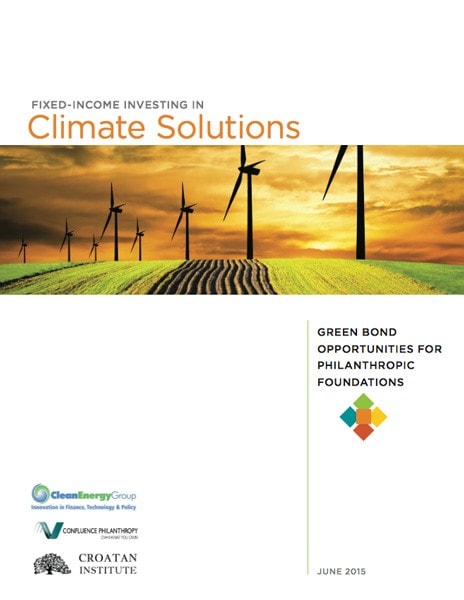Fixed Income Investing in Climate Solutions: Green Bond Opportunities for Philanthropic Foundations
June 23, 2015
Christi Electris, David Roswell, Joshua Humphreys | Clean Energy Group, Confluence Philanthropy, Croatan Institute
Clean Energy Group, Confluence Philanthropy, and Croatan Institute have jointly released the first ever study on the role of green bonds in foundation portfolios. The report, “Fixed Income Investing in Climate Solutions: Green Bond Opportunities for Philanthropic Foundations” focuses on the growing market for green bonds and their potential role as a component of a fossil-free investment strategy for the increasing numbers of foundations committing to divest from fossil fuels.
The report provides an overview on green bonds, the projects they finance, the challenges the market is facing, and the opportunities for foundations to support the market as it rapidly takes off. It builds upon a broader, year-long inquiry conducted by Clean Energy Group and Croatan Institute into the nature of institutional investor demand for green bonds, which involved consultations with more than 50 investors, portfolio managers, foundation officers, underwriters, and other experts in the field, including at a side event to the United Nations Climate Summit held at the Surdna Foundation in September 2014.
“With this study, we have identified numerous ways that green bonds can fit into an integrated philanthropic investment strategy — as mission-related investments, place-based investments, program-related investments, or as part of a Divest-Invest strategy,” according to Joshua Humphreys, president and senior fellow at Croatan Institute and a lead author of the study.
Green bonds are similar to traditional fixed-income products, but are used to finance environmentally beneficial projects, including renewable energy generation and conservation, green building, and clean water infrastructure. Because green bonds have similar investment characteristics to other bonds, they can readily be integrated into foundation portfolios. The financial risks and opportunities associated with climate change and resource constraints make green bonds compelling investment opportunities for any foundation.
“Foundations are increasingly embracing mission-related investing and fossil-fuel divestment,” noted Dana Lanza, CEO of Confluence Philanthropy. “We are pleased to co-sponsor this important resource on green bonds — an immediately available way to invest in climate solutions and other sustainability initiatives.”
The study provides case studies of The Sierra Club Foundation and the Wallace Global Fund, two leading signatories to the Divest-Invest Philanthropy initiative that have integrated green bonds into their investment strategy as part of commitments to divest from fossil fuels and invest in climate solutions. These are only a few examples of foundations that are actively investing in green bonds to align their investments more fully with their mission.
According to Lew Milford, president of Clean Energy Group, “For foundations who want to end reliance on fossil fuels, it is time to invest as well as divest. With green bonds, they have an affirmative opportunity to match their philanthropic dollars with their mission and build the clean energy economy now before it is too late.”
The report concludes with recommendations for how foundations can intervene strategically to cultivate the field of green bonds as part of an integrated investment strategy.





